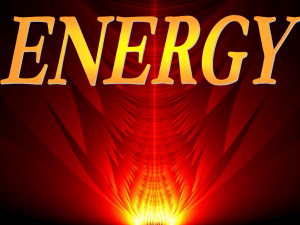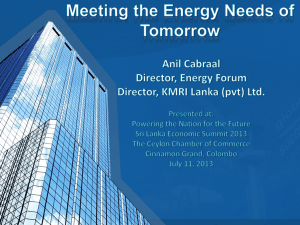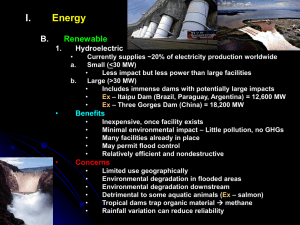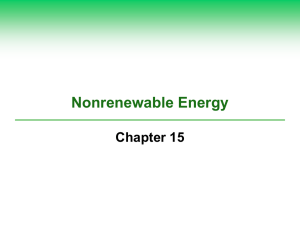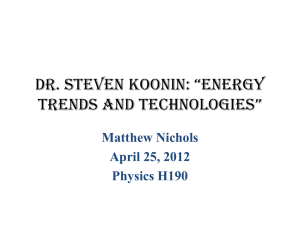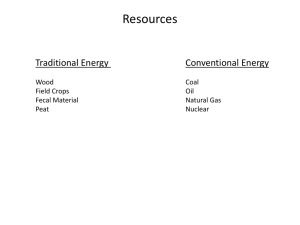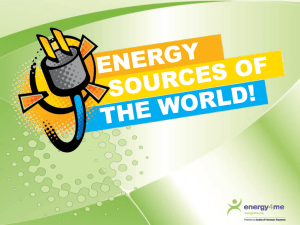crude oil
advertisement
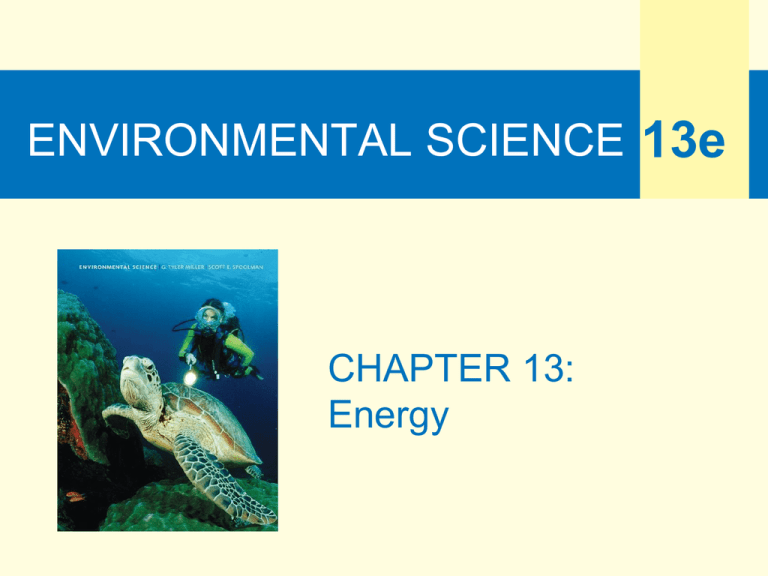
ENVIRONMENTAL SCIENCE 13e CHAPTER 13: Energy Core Case Study: Amory Lovins and the Rocky Mountain Institute (1) • 1984: home and office building in Snowmass, CO • Heat: – Sun – Heavy roof insulation – Thick stone walls – Energy-efficient windows – Waste-heat recovery Core Case Study: Amory Lovins and the Rocky Mountain Institute (2) • Sun – 99% of heat and hot water – 95% of daytime lighting – 90% of household electricity • Energy-efficient electrical appliances and computers • Rocky Mountain Institute – Promotes energy-efficient buildings and transportation Fig. 13-1, p. 296 13-1 What Major Sources of Energy Do We Use? • Concept 13-1A About three-quarters of the world’s commercial energy comes from nonrenewable fossil fuels, and the rest comes from nonrenewable nuclear fuel and renewable sources. • Concept 13-1B Net energy is the amount of high-quality energy available from a resource minus the amount of energy needed to make it available. • What do we need to consider when evaluating energy resources? Evaluating Energy Resources • The supply • The environmental impact • How much net useful energy they provide Commercial energy use by source What can be said about renewable vs non-renewable? Fig. 13-2, p. 298 Science Focus: Net Energy • It takes energy get energy. • What steps are involved in the oil industry that require energy? • Second law of thermodynamics (what happens to the energy at each step?) • Net energy: The usable amount of high quality energy available from a given quantity of an energy resource minus the energy needed to find, extract, process, and get that energy to consumers • Net energy ratio • Ex. Nuclear fuel cycle, how much energy we get out vs how much energy we put in 13-2 What Are the Advantages and Disadvantages of Fossil Fuels? • Concept 13-2 Oil, natural gas, and coal are currently abundant and relatively inexpensive, but using them causes air and water pollution, degrades large areas of land, and releases greenhouse gases to the atmosphere. Dependence on Oil (1) • Petroleum (crude oil) – Also called light oil – Trapped underground or under ocean with natural gas – Fossil fuels • Extraction – U.S. peak production – Global peak production: the point in time when we reach the maximum overall rate of crude oil production for the whole world. Once we pass this point, what will happen to global oil production? Dependence on Oil (2) • Transportation • Refining • Petrochemicals Lowest Boiling Point Gases Gasoline Aviation fuel Heating oil Diesel oil Naphtha Grease and wax Heated crude oil Asphalt Furnace Highest Boiling Point Fig. 13-3, p. 300 Fig. 13-3, p. 300 Supplement 9, Fig. 3, p. S40 How Long Will Crude Oil Supplies Last? • Crude oil is the single largest source of commercial energy in world and U.S. How Long Will Crude Oil Supplies Last? • Crude oil is the single largest source of commercial energy in world and U.S. • Proven oil reserves – Identified deposits that can be extracted profitably at today’s prices with today’s technology How Long Will Crude Oil Supplies Last? • Crude oil is the single largest source of commercial energy in world and U.S. • Proven oil reserves – Identified deposits that can be extracted profitably at today’s prices with today’s technology – Geologists predict known and projected global reserves of crude oil will be 80% depleted between 2050 and 2100 depending on consumption rates What are our options? What are our options? • Look for more oil • Use and waste less oil • Use other energy options • Yes, yes, and yes! 14 13 Barrels of oil per year (billions) 12 11 10 Projected U.S. oil consumption 9 8 7 6 5 4 3 2 Arctic refuge oil output over 50 years 1 0 2000 2010 2020 2030 Year 2040 2050 Fig. 13-4, p. 301 *United States Oil Production and Use (1) • U.S. – 93% of energy from fossil fuels – 39% from crude oil – Produces 9% of world’s crude oil – Uses 25% of world production – Has 2% of proven crude oil reserves United States Oil Production and Use (2) • Domestic oil production – Off-shore drilling – Alaska • Future U.S. production • Consumption versus production • Oil imports – 2008: imported 58% of crude oil Trade-Offs Conventional Oil Advantages Disadvantages Ample supply for 42–93 years Need to find substitutes within 50 years Low cost Large government subsidies High net energy yield Environmental costs not included in market price Easily transported within and between countries Low land use Technology is well developed Efficient distribution system Artificially low price encourages waste and discourages search for alternatives Pollutes air when produced and burned Releases CO2 when burned Can cause water pollution Fig. 13-5, p. 301 Oil Sand • Oil sand (tar sand): mixture of clay, water and bitumen • Bitumen: thick, sticky, tar like heavy oil with high sulfur content • Northeastern Alberta in Canada has ¾ world’s tar sands resources • Under boreal forest • Huge environmental cost Tar sands • http://www.good.is/post/think-nuclearor-coal-is-bad-tar-sands-mining-iscoming-to-utah/ • http://www.youtube.com/watch?v=Yk woRivP17A&feature=related Oil shale • Contain kerogen • Shale Oil • About 72% of world’s estimated oil shale reserves buries in government owed land in US states of Colorado, Wyoming, and Utah in Green River formation • What are the problems? Low net energy, requires huge amount of water to produce (Colorado River System), severe water pollution, air pollution, CO2 emission … Fig. 13-6, p. 303 Trade-Offs Heavy Oils from Oil Shale and Tar Sand Advantages Disadvantages Moderate cost (tar sand) High cost (oil shale) Low net energy yield Large potential supplies, especially tar sands in Canada Easily transported within and between countries Efficient distribution system in place Technology well-developed (tar sand) Environmental costs not included in market price Large amounts of water needed for processing Severe land disruption Severe water pollution Air pollution and CO2 emissions when produced and burned Fig. 13-7, p. 303 Natural Gas Is a Useful and Clean-burning Fossil Fuel (1) • • • • • Natural gas Conventional natural gas Unconventional natural gas Liquefied petroleum gas (LPG) Less carbon dioxide emitted per unit of energy than with crude oil, tar sand, shale oil Natural Gas Is a Useful and Clean-burning Fossil Fuel (2) • Liquefied natural gas (LNG) • World supply of conventional natural gas – 62-125 years • Unconventional natural gas – Coal-bed methane gas – Methane hydrate Trade-Offs Conventional Natural Gas Advantages Disadvantages Ample supplies Nonrenewable resource High net energy yield Releases CO2 when burned Low cost Government subsidies Less air pollution than other fossil fuels Lower CO2 emissions than other fossil fuels Environmental costs not included in market price Methane (a greenhouse gas) can leak from pipelines Easily transported by pipeline Difficult to transfer from one country to another Low land use Good fuel for fuel cells, gas turbines, and motor vehicles Can be shipped across ocean only as highly explosive LNG Fig. 13-8, p. 304 Coal Is a Plentiful But Dirty Fuel (1) • Used in electricity production • World’s most abundant fossil fuel • U.S. reserves should last about 250 years • Sulfur and particulate pollutants • Mercury and radioactive pollutants Coal Is a Plentiful But Dirty Fuel (2) • Heavy carbon dioxide emissions • Pollution control and environmental costs • China major builder of coal plants Increasing moisture content Peat Lignite (not a coal) (brown coal) Heat Pressure Partially decayed plant matter in swamps and bogs; low heat content Increasing heat and carbon content Bituminous (soft coal) Anthracite (hard coal) Heat Heat Pressure Pressure Low heat content; low sulfur content; limited supplies in most areas Extensively used as a fuel because of its high heat content and large supplies; normally has a high sulfur content Highly desirable fuel because of its high heat content and low sulfur content; supplies are limited in most areas Fig. 13-9, p. 305 Waste heat Coal burning power plant Coal bunker Cooling tower transfers waste heat to atmosphere Turbine Generator Cooling loop Stack Pulverizing mill Boiler Condenser Filter Toxic ash disposal Fig. 13-10, p. 306 TVA Coal fired power plant • http://www.tva.com/power/coalart.htm • http://www.newsweek.com/photo/2009/07/ 21/photos--the-worst-man-madeenvironmental-disasters.html Fig. 13-10, p. 306 Coal-fired electricity 286% Synthetic oil and gas produced from coal 150% Coal 100% Tar sand 92% Oil 86% Natural gas Nuclear power fuel cycle Geothermal CO2 Emissions per unit of electrical energy 58% 17% 10% Stepped Art Fig. 13-11, p. 306 Trade-Offs Coal Advantages Disadvantages Ample supplies (225–900 years) Severe land disturbance, air pollution, and water pollution High net energy yield Severe threat to human health when burned Environmental costs not included in market price Low cost Large government subsidies Well-developed technology High CO2 emissions when produced and burned Air pollution can be reduced with improved technology Radioactive particle and toxic mercury emissions Fig. 13-12, p. 307 Case Study: The Growing Problem of Coal Ash • Highly toxic • Often stored in ponds – Ponds can rupture • Groundwater contamination • EPA: in 2009 called for classifying coal ash as hazardous waste – Opposed by coal companies TVA coal ash spill • http://earthfirst.com/americas-top-10worst-man-made-environmental-disasters/ Clean Coal Campaign • Coal industry – Rich and powerful – Fought against labeling carbon dioxide a greenhouse gas • “Clean coal” touted by coal industry – Mining harms the environment – Burning creates carbon dioxide and toxic chemicals • Plan to capture and store carbon dioxide Converting Coal into Gaseous and Liquid Fuels • Synfuels • Coal gasification – Synthetic natural gas (SNG) • Coal liquefaction – Methanol or synthetic gasoline • Extracting and burning coal more cleanly Trade-Offs Synthetic Fuels Advantages Disadvantages Large potential supply Low to moderate net energy yield Higher cost than coal Requires mining 50% more coal Vehicle fuel Environmental costs not included in market price Moderate cost High environmental impact Large government subsidies Lower air pollution than coal when burned High water use Higher CO2 emissions than coal Fig. 13-13, p. 309 13-3 What Are the Advantages and Disadvantages of Nuclear Energy? • Concept 13-3 The nuclear power fuel cycle has a low environmental impact and a very low accident risk, but its use has been limited because of high costs, a low net energy yield, long-lived radioactive wastes, vulnerability to sabotage, and the potential for spreading nuclear weapons technology. How Does a Nuclear Fission Reactor Work? • Nuclear fission • Light-water reactors • Boil water to produce steam to turn turbines to generate electricity • Radioactive uranium as fuel • Control rods, coolant, and containment vessels TVA • http://www.tva.gov/power/nuclear/watt sbar_howworks.htm • http://www.tvakids.com/videos/pressu rized_water_animation.htm Small amounts of radioactive gases Uranium fuel input (reactor core) Control rods Containment shell Heat exchanger Waste heat Steam Turbine Generator Hot coolant Pump Pump Pump Coolant Moderator Shielding Pressure Coolant vessel passage Periodic removal and storage of radioactive wastes and spent fuel assemblies Hot water output Water Periodic removal and storage of radioactive liquid wastes Pump Cool water input Useful electrical energy About 25% Waste heat Condenser Water source (river, lake, ocean) Fig. 13-14, p. 310 Fig. 13-14, p. 310 Safety and Radioactive Wastes • On-site storage of radioactive wastes • Safety features of nuclear power plants • Nuclear fuel cycle • Reactor life cycle • Large amounts of very radioactive wastes Fig. 13-15, p. 311 Fig. 13-15, p. 311 Nuclear Fuel Cycle Decommissioning of reactor Fuel assemblies Enrichment of UF6 Conversion of U3O8 to UF6 Reactor Fuel fabrication (conversion of enriched UF6 to UO2 and fabrication of fuel assemblies) Uranium-235 as UF6 Plutonium239 as PuO2 Temporary storage of spent fuel assemblies underwater or in dry casks Spent fuel reprocessing Low-level radiation with long half-life Mining uranium ore (U3O8 ) Open fuel cycle today Recycling of nuclear fuel Geologic disposal of moderate and high-level radioactive wastes Fig. 13-16, p. 312 What Happened to Nuclear Power? • Optimism of 1950s is gone • Comparatively expensive source of power • No new plants in U.S. since 1978 • Disposing of nuclear waste is difficult • Three Mile Island (1979) Japan’s Nuclear Disaster • http://www.guardian.co.uk/world/video/201 1/mar/14/japan-tsunami-amateur-footagevideo Case Study: Chernobyl Disaster • Ukraine (1986) • Explosions and partial meltdown • Huge radioactive release to atmosphere • Estimated death toll: 9,000–212,000 • Radioactive fallout and long-term health effects • Lesson – worldwide consequences Trade-Offs Conventional Nuclear Fuel Cycle Advantages Disadvantages Large fuel supply Cannot compete economically without huge government subsidies Low environmental impact (without accidents) Low net energy yield High environmental impact (with major accidents) Emits 1/6 as much CO2 as coal Moderate land disruption and water pollution (without accidents) Moderate land use Environmental costs not included in market price Risk of catastrophic accidents No widely acceptable solution for long-term storage of radioactive wastes Subject to terrorist attacks Low risk of accidents because of multiple safety systems (except for Chernobyl-type reactors) Spreads knowledge and technology for building nuclear weapons Fig. 13-17, p. 313 Trade-Offs Coal vs. Nuclear Coal Nuclear Ample supply Ample supply of uranium High net energy yield Very high air pollution High CO2 emissions High land disruption from surface mining Low net energy yield Low air pollution Lower CO2 emissions Much lower land disruption from surface mining High land use Moderate land use Low cost (with huge subsidies) High cost (even with huge subsidies) Fig. 13-18, p. 314 Nuclear Power Is Vulnerable to Terrorist Acts • Insufficient security • On-site storage facilities • U.S.: 161 million people live within 75 miles of an above-ground nuclear storage site Dealing with Radioactive Wastes • High-level radioactive wastes • Long-term storage: 10,000–240,000 years • Deep burial • Detoxify wastes? Case Study: Dealing with Radioactive Wastes in the United States • Yucca Mountain, Nevada • Concerns over groundwater contamination • Possible seismic activity • Transportation accidents and terrorism • 2009: Obama ends Yucca funding What Do We Do with Worn-Out Nuclear Power Plants? • Decommissioning old nuclear power plants • Dismantle power plant and store materials • Install physical barriers • Entomb entire plant What Is the Future for Nuclear Power? • • • • • Reduce dependence on foreign oil Reduce global warming Advanced light-water reactors Nuclear fusion How to develop relatively safe nuclear power with a high net energy yield? 13-4 Why Is Energy Efficiency an Important Energy Source? • Concept 13-4 The United States could save as much as 43% of all the energy it uses by improving the energy efficiency of industrial operations, motor vehicles, and buildings. Improving Energy Efficiency • Energy efficiency – How much work we get from each unit of energy we use • Reducing energy waste – 41% of all commercial energy in U.S. is wasted unnecessarily • Numerous economic and environmental advantages Energy Inputs System Outputs 9% 7% 41% 85% U.S. economy 43% 8% 4% 3% Nonrenewable fossil fuels Useful energy Nonrenewable nuclear Petrochemicals Hydropower, geothermal, Wind, solar Biomasss Unavoidable energy waste Unnecessary energy Fig. 13-19, p. 319 Examples of Energy-Wasting Devices • • • • Incandescent light bulb Internal combustion engine Nuclear power plants Coal-burning power plants Saving Energy and Money in Industry • Cogeneration/Combined Heat and Power (CHP) systems • Recycling • Energy-saving electric motors • Fluorescent lighting • Smart grid electricity Saving Energy and Money in Transportation • 2/3 of U.S. oil consumption • Low fuel-efficiency standards for vehicles • Hidden costs: $12/gallon of gas • Raise gasoline taxes/cut payroll and income taxes • Tax breaks for fuel-efficient vehicles Hybrid and Fuel-Cell Cars • • • • • Super-efficient and ultralight cars Gasoline-electric hybrid car Plug-in hybrid electric car Hydrogen fuel cells Accessible mass-transit systems as alternative Cars 20 Cars, trucks, and SUVs Trucks and SUVs 15 10 1975 1980 1985 1990 1995 Year 2000 2005 Miles per gallon (mpg) (converted to U.S. test equivalents) Average fuel economy (miles per gallon) 25 50 45 Europe 40 Japan China 35 Canada 30 25 United States 20 2002 2004 2006 2008 Year Stepped Art Fig. 13-21, p. 320 Conventional hybrid Fuel tank Plug-in hybrid Fuel tank Battery Battery Internal combustion engine Transmission Electric motor Internal combustion engine Transmission Electric motor Stepped Art Fig. 13-22, p. 321 Saving Energy and Money in New Buildings • Green architecture • Solar cells, fuel cells, eco-roofs, recycled materials • Super insulation • Straw bale houses Saving Energy in Existing Buildings • • • • • • Insulate and plug leaks Use energy-efficient windows Heat houses more efficiently Heat water more efficiently Use energy-efficient appliances Use energy-efficient lighting Fig. 13-23, p. 322 Attic • Hang reflective foil near roof to reflect heat. • Use house fan. • Be sure attic insulation is at least 30 centimeters (12 inches). Bathroom • Install water-saving toilets, faucets, and shower heads. • Repair water leaks promptly. Kitchen • Use microwave rather than stove or oven as much as possible. • Run only full loads in dishwasher and use low- or no-heat drying. • Clean refrigerator coils regularly. Basement or utility room • Use front-loading clothes washer. If possible run only full loads with warm or cold water. • Hang clothes on racks for drying. • Run only full loads in clothes dryer and use lower heat setting. • Set water heater at 140° if dishwasher is used and 120° or lower if no dishwasher is used. • Use water heater thermal blanket. • Insulate exposed hot water pipes. • Regularly clean or replace furnace filters. Outside Plant deciduous trees to block summer sun and let in winter sunlight. Other rooms • Use compact fluorescent lightbulbs or LEDs and avoid using incandescent bulbs wherever possible. • Turn off lights, computers, TV, and other electronic devices when they are not in use. • Use high efficiency windows; use insulating window covers and close them at night and on sunny, hot days. • Set thermostat as low as you can in winter and as high as you can in summer. • Weather-strip and caulk doors, windows, light fixtures, and wall sockets. • Keep heating and cooling vents free of obstructions. • Keep fireplace damper closed when not in use. • Use fans instead of, or along with, air conditioning. Stepped Art Fig. 13-24, p. 324 Why Are We Still Wasting So Much Energy? • Energy costs relatively little • Lack of government support and economic incentives • Inadequate building codes • Inadequate appliance standards • Lack of information about saving energy 13-5 What Are Advantages/Disadvantages of Renewable Energy Resources? • Concept 13-5 Using a mix of renewable energy sources – especially sunlight, wind, flowing water, sustainable biomass, and geothermal energy – can drastically reduce pollution, greenhouse gas emissions, and biodiversity losses. Renewable Energy • Sustainability mostly depends on solar energy – Direct form: from the sun • Indirect forms – Wind – Moving water – Biomass • Geothermal Benefits of Shifting to Renewable Energy Resources (1) • • • • More decentralized, less vulnerable Improve national security Reduce trade deficits Reduce air pollution Benefits of Shifting to Renewable Energy Resources (2) • Create jobs • Save money • Renewable energy handicapped by – Unbalanced, intermittent subsidies – Inaccurate pricing Using Solar Energy to Heat Buildings and Water • Passive solar heating system • Active solar heating system Fig. 13-25, p. 325 Fig. 13-25, p. 325 Summer sun Vent allows hot air to escape in summer Heavy insulation Winter sun Superwindow Superwindow Stone floor and wall for heat storage PASSIVE Fig. 13-25, p. 325 Supplement 9, Fig. 5, p. S41 Trade-Offs Passive or Active Solar Heating Advantages Disadvantages Energy is free Need access to sun 60% of time Net energy is moderate (active) to high (passive) Quick installation Sun can be blocked by trees and other structures Environmental costs not included in market price No CO2 emissions Need heat storage system Very low air and water pollution Very low land disturbance (built into roof or windows) Moderate cost (passive) High cost (active) Active system needs maintenance and repair Active collectors unattractive Fig. 13-26, p. 326 Solar Energy for HighTemperature Heat and Electricity • • • • Solar thermal systems Solar thermal plant Solar cookers Photovoltaic (solar) cells Trade-Offs Solar Energy for High-Temperature Heat and Electricity Advantages Disadvantages Moderate environmental impact Low efficiency No CO2 emissions Low net energy High costs Environmental costs not included in market price Fast construction (1–2 years) Costs reduced with natural gas turbine backup Needs backup or storage system Needs access to sun most of the time May disturb desert areas Fig. 13-27, p. 326 Single solar cell Solar-cell roof Boronenriched silicon Junction Phosphorusenriched silicon Roof options Panels of solar cells Solar shingles Fig. 13-29, p. 328 Fig. 13-30, p. 328 Trade-Offs Solar Cells Advantages Disadvantages Fairly high net energy yield Need access to sun Work on cloudy days Low efficiency Quick installation Need electricity storage system or backup Easily expanded or moved No CO2 emissions Low environmental impact Last 20–40 years Environmental costs not included in market price High costs (but should be competitive in 5–15 years) Low land use (if on roof or built into walls or windows) High land use (solar-cell power plants) could disrupt desert areas Reduces dependence on fossil fuels DC current must be converted to AC Fig. 13-31, p. 328 Producing Electricity from Flowing Water • Hydropower – Leading renewable energy source – Much unused capacity • Dams and reservoirs – Turbines generate electricity – Eventually fill with silt • Micro-hydro generators Trade-Offs Large-Scale Hydropower Advantages Disadvantages Moderate to high net energy High construction costs High efficiency (80%) High environmental impact from flooding land to form a reservoir Large untapped potential Low-cost electricity Long life span No CO2 emissions during operation in temperate areas Can provide flood control below dam Environmental costs not included in market price High CH4 emissions from rapid biomass decay in shallow tropical reservoirs Danger of collapse Uproots people Decreases fish harvest below dam Provides irrigation water Reservoir useful for fishing and recreation Decreases flow of natural fertilizer (silt) to land below dam Fig. 13-32, p. 329 Producing Electricity from Wind • Indirect form of solar energy • World’s second fastest-growing source of energy • Vast potential – Land – Offshore Supplement 9, Fig. 8, p. S43 Trade-Offs Wind Power Advantages Disadvantages Moderate to high net energy yield Steady winds needed High efficiency Backup systems needed when winds are low Moderate capital cost Low electricity cost (and falling) Very low environmental impact Plastic components produced from oil Environmental costs not included in market price No CO2 emissions High land use for wind farm Quick construction Visual pollution Easily expanded Can be located at sea Noise when located near populated areas Land below turbines can be used to grow crops or graze livestock Can kill birds and interfere with flights of migratory birds if not sited properly Fig. 13-34, p. 331 Energy from Burning Biomass • Biomass – Wood – Agricultural waste – Plantations – Charcoal – Animal manure • Common in developing countries • Carbon dioxide increase in atmosphere Converting Plant Matter to Liquid Biofuel • Biofuels – Ethanol and biodiesel – Crops can be grown in most countries – No net increase in carbon dioxide emissions – Available now • Sustainability Trade-Offs Biodiesel Advantages Disadvantages Reduced CO emissions Increased NOx emissions and more smog Reduced CO2 emissions (78%) Higher cost than regular diesel High net energy yield for oil palm crops Environmental costs not included in market price Moderate net energy yield for rapeseed crops Reduced hydrocarbon emissions Low net energy yield for soybean crops May compete with growing food on cropland and raise food prices Better gas mileage (40%) Loss and degradation of biodiversity from crop plantations Potentially renewable Can make engines hard to start in cold weather Fig. 13-35, p. 333 Fig. 13-36, p. 334 Trade-Offs Ethanol Fuel Advantages Disadvantages High octane Lower driving range Low net energy yield (corn) Some reduction in CO2 emissions (sugarcane bagasse) High net energy yield (bagasse and switchgrass) Higher CO2 emissions (corn) Much higher cost Environmental costs not included in market price May compete with growing food and raise food prices Can be sold as a mixture of gasoline and ethanol or as pure ethanol Higher NOx emissions and more smog Corrosive Potentially renewable Can make engines hard to start in cold weather Fig. 13-37, p. 335 http://articles.cnn.com/2008-0401/tech/algae.oil_1_algae-research-fossilfuels-nrel?_s=PM:TECH Energy by Tapping the Earth’s Internal Heat • Geothermal energy • Geothermal heat pumps • Hydrothermal reservoirs – Steam – Hot water • Deep geothermal energy Supplement 9, Fig. 9, p. S43 Supplement 9, Fig. 10, p. S44 Trade-Offs Geothermal Energy Advantages Disadvantages Very high efficiency Scarcity of suitable sites Moderate net energy at accessible sites Lower CO2 emissions than fossil fuels Can be depleted if used too rapidly Environmental costs not included in market price CO2 emissions Low cost at favorable sites Moderate to high local air pollution Low land use and disturbance Noise and odor (H2S) Moderate environmental impact High cost except at the most concentrated and accessible sources Fig. 13-38, p. 336 Can Hydrogen Replace Oil? • Hydrogen is environmentally friendly • Problems – Most hydrogen is in water – Net energy yield is negative – Fuel is expensive – Air pollution depends on production method – Storage Trade-Offs Hydrogen Advantages Can be produced from plentiful water Fuel cell Disadvantages Not found as H2 in nature Energy is needed to produce fuel Low environmental impact Negative net energy Renewable if produced from renewable energy resources CO2 emissions if produced from carbon-containing compounds No CO2 emissions if produced from water Environmental costs not included in market price Good substitute for oil Nonrenewable if generated by fossil fuels or nuclear power Competitive price if environmental and social costs are included in cost comparisons High costs (that may eventually come down) Easier to store than electricity Safer than gasoline and natural gas Will take 25 to 50 years to phase in Short driving range for current fuel-cell cars Nontoxic No fuel distribution system in place High efficiency (45–65%) in fuel cells Excessive H2 leaks may deplete ozone in the atmosphere Fig. 13-39, p. 337 Science Focus: The Quest to Make Hydrogen Workable • Bacteria and Algae • Electricity from solar, wind, geothermal • Storage: liquid and solid • Preventing explosions 13-6 How Can We Make the Transition to a More Sustainable Energy Future? • Concept 13-6 We can make a transition to a more sustainable energy future by greatly improving energy efficiency, using a mix of renewable energy resources, and including environmental costs of energy resources in their market prices. Transition to a More Sustainable Energy Future (1) • For each energy alternative: – How much available next 25-50 years? – Estimated net energy yield – Total costs – Necessary subsidies and tax breaks – How affect economic and military security – Vulnerability to terrorism – Environmental effects Decentralized Power System Bioenergy power plants Wind farm Small solar-cell power plants Fuel cells Solar-cell rooftop systems Rooftop solarcell arrays Smart electrical and distribution system Commercial Residential Small wind turbine Industrial Microturbines Stepped Art Fig. 13-40, p. 339 Transition to a More Sustainable Energy Future (2) • Gradual shift from centralized macropower to decentralized micropower • Greatly improved energy efficiency • Temporary use of natural gas • Decrease environmental impact of fossil fuels Solutions Making the Transition to a More Sustainable Energy Future Improve Energy Efficiency Increase fuel-efficiency standards for vehicles, buildings, and appliances More Renewable Energy Mandate government purchases of efficient vehicles and other devices Include environmental costs in prices for all energy resources Provide large tax credits or feebates for buying efficient cars, houses, and appliances Offer large tax credits for investments in energy efficiency Reward utilities for reducing demand for electricity Greatly increase energy efficiency research and development Greatly increase use of renewable energy Provide large subsidies and tax credits for use of renewable energy Encourage government purchase of renewable energy Greatly increase renewable energy research and development Reduce Pollution and Health Risk Cut coal use 50% by 2020 Phase out coal subsidies and tax breaks Levy taxes on coal and oil use Phase out nuclear power subsidies, tax breaks, and loan guarantees Fig. 13-41, p. 340 Economic, Political, and Educational Strategies to Sustainable Energy • Requires government strategies • Keep prices low in selected resource to encourage use – Same strategy for fossil fuels and nuclear power • Keep prices high in selected resource to discourage use • Emphasize consumer education Three Big Ideas from This Chapter - #1 Energy resources should be evaluated on the basis of their potential supplies, how much net useful energy they provide, and the environmental impact of using them. Three Big Ideas from This Chapter - #2 Using a mix of renewable energy – especially sunlight, wind, flowing water, sustainable biofuels, and geothermal energy – can drastically reduce pollution, greenhouse gas emissions, and biodiversity losses. Three Big Ideas from This Chapter - #3 Making the transition to a more sustainable energy future requires sharply reducing energy waste, using a mix of environmentally friendly renewable energy resources, and including the harmful environmental costs of energy resources in their market prices.

